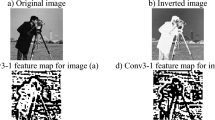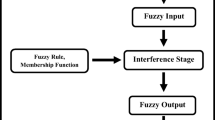Abstract
Image classification is a challenging problem of computer vision. This study reports a fuzzy system to semantic image classification. As it is a complex task, various information of digital image, including three color space components and two Zernike moments with different order, are gathered and utilized as an input of fuzzy inference system to materialize a robust rotation/lighting condition and size invariant image classifier. For better performance, all the membership functions are optimized by genetic algorithm after empirical design stage. 90.62 and 96.25 % classification rates for RGB and HSI color spaces confirm the reliability of optimized system in different image conditions given in this contribution.
Similar content being viewed by others
References
Figueiredo V.M., Jain A.K., Zhang H.-J.: Image classification for content-based indexing. In: IEEE Trans. Image Process. 10(1), 117–130 (2001)
Wang D., Shik Lim J., Han M.-M., Lee B.-W.: Learning similarity for semantic images classification. Neurocomputing 67, 363–368 (2005)
Zadeh L.A.: Fuzzy sets. Inf. Control 8, 338–353 (1965)
Zimmermann H.-J.: Fuzzy Set Theory and its Applications. Kluwer Academic Publishers, Boston (1996)
Dubois D., Prade H.: The three semantics of fuzzy sets. Fuzzy Sets Syst. 90, 141–150 (1997)
Hisdal E.: Are grades of membership probabilities?. Fuzzy Sets Syst. 25, 325–348 (1988)
Turksen I.B.: Measurement of membership functions and their acquisition. Fuzzy Sets Syst. 40, 5–38 (1991)
Medasani S., Kim J., Krishnapuram R.: An overview of membership function generation techniques for pattern recognition. Int. J. Approx. Reason. 19, 391–417 (1998)
Chen M.-S., Wang S.-W.: Fuzzy clustering analysis for optimizing membership functions. Fuzzy Sets Syst. 103, 239–254 (1999)
Runkler T.A., Bezdek J.C.: Function approximation with polynomial membership functions and alternating cluster estimation. Fuzzy Sets Syst. 101, 207–218 (1999)
Sivanandum S.N., Sumathi S., Deepa S.N.: Introduction to Fuzzy Logic Using MATLAB. Springer, Berlin (2007)
Haupt R.L., Haupt S.E.B.: Practical Genetic Algorithms, 2nd edn. Wiley, New York (2004)
Hu M.: Visual pattern recognition by moment invariants. IRE Trans. Inf. Theory 8, 179–187 (1962)
Teh C., Chin R.T.: On image analysis by the method of moments. In: IEEE Trans. PAMI 10(4), 496–513 (1988)
Prokop R.J., Reeves A.P.: A survey of moment-based techniques for un-occluded object representation and recognition. CVGIP GMIP 54(5), 438–460 (1992)
Kim H.-J., Kim W.-Y.: Eye detection in facial images using Zernike moments with SVM. ETRI J. 30(2), 335–337 (2008)
Khotanzad, A., Hong, Y.H.: Rotation invariant image recognition using features selected via a systematic method. Pattern Recogn. 23(10), 1089–1101
Teague M.R.: Image analysis via the general theory of moments. J. Opt. Soc. Am. 70(8), 920–930 (1980)
Sivanandam S.N., Deepa S.N.: Introduction to Genetic Algorithms, pp. 165–209. Springer, Berlin (2008)
Yazdi H.S., Nasiri J.A.: Fuzzy image segmentation using human interaction. J. Appl. Sci. Res. 5, 722–728 (2009)
Kim S.: Image denoising via diffusion modulation. Int. J. Pure Appl. Math. 30, 71–92 (2006)
Molnar S., Klinko P.: Detecting amorphously shaped objects in a noisy imaging environment. Int. J. Pure Appl. Math. 61, 11–20 (2010)
Schmeelk J.: Medical image edge detectors. Int. J. Pure Appl. Math. 67, 341–354 (2011)
Zavidovique B., Seetharaman G.: Z-trees and Peano rasters for scan adaptive image processing. Int. J. Pure Appl. Math. 38, 123–150 (2007)
Author information
Authors and Affiliations
Corresponding author
Rights and permissions
About this article
Cite this article
Mousavi, B.S., Soleymani, F. & razmjooy, N. Semantic image classification by genetic algorithm using optimised fuzzy system based on Zernike moments. SIViP 8, 831–842 (2014). https://doi.org/10.1007/s11760-012-0311-7
Received:
Revised:
Accepted:
Published:
Issue Date:
DOI: https://doi.org/10.1007/s11760-012-0311-7




